

Dixie State University Library & Learning Services, including the Library, Special Collections & Archives, the Writing Center, and the Academic Performance Centers, provides the resources necessary to facilitate research and enhance the curriculum and programs of Dixie State University. Library & Learning Services delivers innovative services and opportunities, both of which promote and support learning and intellectual engagement for students, faculty, staff, and community.
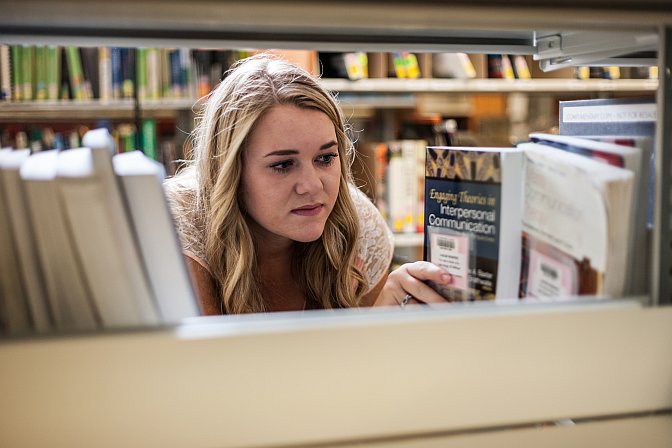
Library & Learning Services is committed to…
Dixie State University Library & Learning Services is central to the learning environment of DSU and is a welcoming destination for the discovery and creation of knowledge both physically and online. We will excel in offering expert guidance, valuable resources, and state of the art technologies. We will enhance student’s learning and will foster a welcoming atmosphere that encourages diversity, exploration, positive learning, and personal development.
| Priority | Selected Tasks |
|---|---|
| 1. Embed information literacy into the curriculum |
|
| 2. Expand resources and enhance services |
|
| 3. Contribute to campus-wide retention efforts |
|
| 4. Remove Barriers to Access and Improve Efficiencies |
|
The creation of a comprehensive assessment plan based on the library and learning services strategic plan was a major accomplishment this year. This plan can be found at https://library.dixie.edu/info/assessment-plan.pdf
The following program summaries are based on the goals and objectives identified in the strategic plan and assessment plan and encompass those identified in last year’s annual report. The full annual reports for each department (including department and program SWOT analyses) can be found on our website https://library.dixie.edu/info/mission_and_planning.html#ar
Strategy: Increase faculty requests for workshops using primary sources
Results: Collection use increased again this year and was driven by classes that integrated primary sources from Special Collections & Archives into coursework. Three general education history classes (HIST 2700 and 2710) used the oral history collection as primary sources for student research papers. For the first time, HIST 3000 - Historical Research Methodologies used the primary sources in special collection to get a hands on experience analyzing primary sources.
Strategy: Increase librarian presence in classes.
Results: Instruction sessions have increased by 100% in English general education classes. Information literacy modules have been integrated into Canvas. CLO’s and PLO’s were approved for LLS-prefix classes. Librarians are embedded in programs including health sciences, nursing, biology and the the Maker Certificate program.
Strategy: Implement Research Consultation appointments with a subject liaison librarian.
Results: This program was started in August 2018 as a trial to assess demand for a service of this type. The results have been very positive. With little advertising or outreach, students scheduled 89 appointments. Subject librarians foresee demand only increasing as students become more aware of this service. Librarians report having a better quality of interaction with students, and the ability to offer more in-depth assistance.
Strategy: Increase library materials budgets.
Results: Some progress has been made towards this goal. The library received an ongoing operating budget increase of $30,000 for Applied Sociology, Sports Management, and Mechanical Engineering. Funds from this increase were used to purchase various perpetual e-reference books for these areas, plus a bonus of free access to other e-reference books for other study areas. John Burns, the Electronic Database librarian, has also negotiated with five of our library’s electronic database vendors for reductions of over $23,000 in annual costs.
Strategy: Pursue PTRC (Patent and Trademark Resource Center) library designation
Results: Because of budget freezes and other factors, the library did not receive notification of acceptance or denial of PTRC status, but was placed on hold last year. The library has been notified that those libraries who continued attending training were more likely to receive PTRC status this year, but will not be notified until after October 2019.
Strategy: Work with department chairs to further develop the Writing Center’s departmental tutoring program, and hire more-qualified tutors for the Academic Performance Center.
Results: The Writing Center partially accomplished this goal. Inadequate funding prevented them from expanding departmental tutoring services above adding one departmental tutor for the Nursing Department. This goal is now feasible as Student Government increased student fees for the Writing Center from $4.00 per FTE student per semester to $6.50. The Academic Performance Center created a new policy where tutors must be recommended by at least two faculty members and each must have received an A or A- in each course they tutor. This has improved the reputation of the APC and made faculty feel more involved with the process.
Strategy: Improve the quality of tutoring in the Writing Center and Academic Performance Center by instituting a continuing education program for tutors and implementing CRLA certification into tutor training courses. CRLA certification applications will be completed for Writing Center and the Academic Performance Center.
Results: CRLA certification was approved for both the Writing Center and APC. In addition to other requirements, this meant adding CRLA requirements into our two tutor training courses for the Writing Center (Engl 2790, English 2791R) and developing a tutor training course for APC tutors (LLS 2790). The goal to complete a tutoring continuing education program is still feasible, and as a first step Learning Services created a continuing education Canvas shell for Writing Center tutors.
Strategy: Create additional LLS courses
Results: Learning Services accomplished this goal by adding two peer mentor-training courses: LLS 2780- mentoring for peer coaches and LLS 2770, mentoring for supplemental instruction leaders.
They also created master courses for LLS 2790, LLS 2780, and LLS 2770. Their total student count in these courses for 2019-2020 was 50 (LLS 2770 debuts Fall 2019).
Strategy: Build digital collections infrastructure
Results: Some progress has been made towards this goal. Work has continued for creating digital reproductions of archival collection materials in preparation for a DSU digital collection. The Kardas Family Trust in the previous fiscal year had given a $10,000 donation for processing and digital collection work. The Kardas Collection is almost fully processed, so digitization work has begun. Once enough of the Kardas digitization work has been completed the remainder of the donated funds can be used to assist with the purchase of a DAMS (estimated cost $8500-10,000 annually). In addition, a new Special Collections server through DSU IT was purchased ($6,500 as one-time fee for the server, and annual fees of $1,310 for backups, and $305 for Archives Space).
Strategy: Provide leadership for OER on campus
Results: The Library in collaboration with the Center for Teaching and Learning, and Digital and Extended Learning applied for and received an Atwood Retention Grant to promote OER use across high enrollment classes. To date, a faculty survey has been completed, a first round of proposals has been conducted with two projects approved to be implemented in Fall 2019, and a second round of proposals have been announced for implementation in Spring 2020. This will be a continual project throughout the next year.
Strategy: Participate in FYE - Trailblazer Connections
Results: Departments contributed to this effort in many ways including faculty serving as instructors, creating materials, and conducting workshops.
Strategy: Assess impact of resources and services on student learning and success
Results: Results of MISO survey suggest a strong correlation between the library and academic success. For instance, 61 percent of faculty said that accessing scholarly materials greatly contributed to them meeting their teaching goals. 62 percent of students said the “physical and digital library collections” contributed greatly or moderately to achieving their academic goals and 87 percent said the “ability to access the scholarly material from anywhere” contributed greatly or moderately to their academic goals.
A full analysis of the results is available at https://library.dixie.edu/info/MISO-survey-2019.pdf
Strategy: Re-evaluate, document and revise internal policies, procedures, and guidelines
Results: Technical Services has started the revision of processing policies including revising the gift processing, library ordering, processing periodical guidelines. Several other policies, procedures and guidelines for acquisitions, processing, cataloging, access, work in the bindery, and the annual inventory process still need to be re-evaluated, documented and revised.
Strategy: Create collection reports detailing titles, publication dates, usage, date, etc.
Results: Brookanna Alford created reports listing these items and made them available to subject liaison librarians
Strategy: Redesign web pages for user experience
Results: Caleb Ames (L&LS IT systems) has completed some upgrading and redesign of the library’s web page, other areas on the webpage will need further changes. Redesigning pages using responsive design, optimized for mobile viewing and page load speed was completed this year.
Strategy: Evaluate the outdated and obsolete library’s Integrated Library System
Results: Caleb Ames was able to successfully compare various possible ILS replacements and their costs. Ultimately, it was decided for now to upgrade the current ILS system, as it would cover the library’s immediate needs. The library ILS and its server were successfully updated 5–6 May 2019. L&LS IT systems coordinated with vendors and the DSU IT department to perform this update and data migration. This upgrade was necessary to meet data security requirements, but will also increase the speed of searches and provide a foundation for future improvements.
Strategy: Re-evaluate and revise internal policies, procedures, and guidelines.
Results: Special Collections & Archives reviewed, revised, and greatly expanded policies regarding use, collecting scope, accession / deaccession, and licensing and use. Several user and legal forms were updated at the same time. A bundle of policies and forms are currently in the approval process.
Strategy: Develop multiple advertising strategies to reach both faculty and students in order to increase the number of consultations the Writing Center and Academic Performance Center completes each year.
Results: Created and implemented a marketing plan.
Strategy: Create an LLS Newsletter
Results: The Academic Performance Center created a Library & Learning Services internship class, which enabled Learning Services to have student interns create a newsletter to promote LLS goals and highlight LLS information for the entire campus to access.
Strategy: Assess the Writing Center’s and Academic Performance Center’s current traffic and capacity by reviewing week-by-week, day-by-day, and hour-by-hour consultation data to accommodate students’ tutoring needs as efficiently as possible, with tutoring hours corresponding directly with demand.
Results: Learning Services completed this goal. They adjusted the number of tutors on staff during various days of the week and hours of the day according to demand. They added online tutoring during all our open hours plus extended evening and Saturday hours.
Strategy: Re-evaluate and revise internal policies, procedures and guidelines.
Results: Policy 613 Library & Learning Services revised and approved. Checklist items required by NWCCU created or revised as necessary.
Strategy: Implement new circulation procedures; including extended checkout periods, and simplified replacement process.
Results: Term long checkouts have been implemented. This has been very helpful in eliminating barriers to student borrowing. This has also slightly improved staff workflow by not spending large amounts of time on very small fines. Patrons generally like the new system, but are confused about the “grace period”. This will be addressed with the new ILS system upgrade.
Strategy: Re-evaluate and revise internal policies, procedures and guidelines.
Results: Extensive review of all internal circulation, fines, lending and other internal policies were revised to reflect current practices. Based on faculty feedback, the limit on number of items checked out was raised for both faculty and students.
David Zielke: Attended the United States Patent and Trademark Office training for Patent and Trademark Resource Centers in April 2019. He attended the Utah state STEM Librarians Boot Camp, and the Utah Library Association Conference.
Kathleen Broeder: Serves as vice-president of the Washington County Historical Society (WCHS), as a board member of DASIA, and as an advisory board member to the Daughters of Utah Pioneers McQuarrie Museum Board. Attended an NEH funded European trip to learn about the romantic era. Research includes starting a Fundamental Mormon Oral History Project, and an accepted book proposal (with Dianne Aldrich) for a historical photo book of Utah’s Dixie.
Tracey O’Kelly: Completed a 6 week course on the Fundamentals in Cataloging through the Association for Library Collections & Technical Services.
Dianne Aldrich: Presented a poster session on integrating information literacy throughout the GE Curriculum at Library Instruction West Conference, summer 2018. She is currently working on an article submission focusing on the future of academic libraries.
John Burns: Attended the ARLIS/NA (The Art Libraries Society of North America) national conference in March 2019. Past Chair of the conference proposal committee with the mountain west chapter. Hosted the annual conference in SLC. Presented “Insight and Impact: Thriving as a Solo Art Information Professional” at a session of the Solo Art Librarian Special Interest Group and was the incoming moderator for the Visual Resources Special Interest Group. Volunteered as a mentor to a new art librarian at the University of Texas.
Emma Lanners: Attended the Utah state STEM Librarian Boot Camp.
Rob Gray: Attended the Utah CRLA convention and the national CRLA convention. He also attended tutor center management training at Engineerica’s corporate office.
Braxton Thornley: University Valedictorian for 2018–2019. He accepted an offer to teach English at Bingham High School. He also wrote articles for the DSU Annual Academic Report.
Brittany Bennett: History Department student of the year and wrote articles for the DSU Annual Academic Report.
Emma Lee: Presented her senior thesis at the Sigma Tau Delta national convention and was the managing editor for the LLS Newsletter. She graduated from DSU this spring and has accepted an offer to attend USU Master of Technical Writing program in the fall.
| Name and Degree | Tenure Status
T = Tenured TT = Tenure Track NTT = Non Tenure Track |
Rank | Faculty FTE | Released Time in Credit Hours |
|---|---|---|---|---|
| Dianne Aldrich, MSLIS | T | Librarian | 1 | n/a |
| Caleb Ames, MSIS | T | Associate Librarian | 1 | n/a |
| Kathleen Broeder, MA, MSIS | TT | Assistant Librarian | 1 | n/a |
| John Burns, MLIS | T | Associate Librarian | 1 | n/a |
| Linda Jones, MA, MLIS | T | Librarian | 1 | n/a |
| David Zielke, MLIS | T | Librarian | 1 | n/a |
| Rob Gray, MFA | NTT | Interim Director | 1 | n/a |
Adjunct Information:
Received, processed, and cataloged a large collection of music library materials previously kept in the Music Department. Over one thousand items were added to the collection. Brookanna Alford completed an inventory of the entire physical library materials collection.
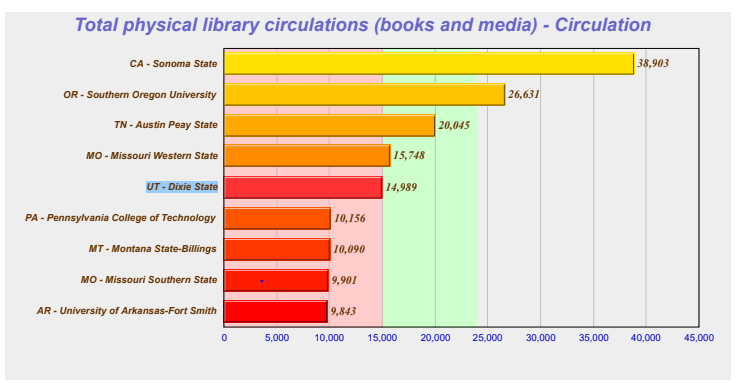
Use of library collections is continuing to increase, both in print and electronic collections. In particular, the physical collection use is very robust. When compared to peer institutions, DSU’s library has the smallest budget for materials but it is fifth in circulation of physical library materials. This demonstrates the deep collaborations DSU’s subject liaison librarians have with faculty that results in highly relevant collection purchases.
Interlibrary loan continues to be heavily used with 938 loans received for DSU library patrons and 693 items provided to other libraries. The amount borrowed for library patrons has remained largely consistent from last year, but DSU’s library is lending more to other libraries. Since interlibrary loan is a cooperative arrangement between libraries, DSU’s library makes every attempt to loan items to other libraries to help bring lending and borrowing numbers to a more equal level.
This year has marked a change in how cataloging of the rare book collection is processed. Special Collections staff now complete all stages of book processing, with quality control checked by the Head of Technical Services. As a result, in the rare book collection a significant amount of copy cataloging processing has occurred this year. The book catalog had 122 new items and 86 duplicate copies added. Processing of archival collections has also significantly increased. In total, 23 archival collections have been completed, and 2 almost completed, representing 100 linear feet (a 150% growth of linear feet from last year’s 40). In addition, Special Collections has added 20 accessions this year including wood block printing negatives of local images, 110 volumes of historic newspapers from 6 different titles (1896–1960s with duplicate and new titles), a 75th DSU Anniversary commemorative coin, and the St. George Motor Court / Motel Association Minutes from mid-century. Special Collections use by classes has increased dramatically, especially for the oral histories collection.
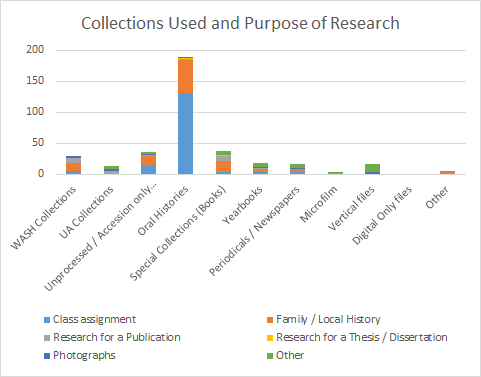
During the fall 2018 semester, the Writing Center completed 1,720 consultations, a 17 percent increase in total consultations over the spring 2018 semester. During the 2018-2019 academic year, the Writing Center completed 3,194 consultations, a 13 percent increase in total consultations over the previous academic year. Between the 2017-2018 academic year and the 2018-2019 year, the number of synchronous online tutoring sessions that the Writing Center completed increased by 92 percent, from 179 online tutoring sessions to 344.
The Writing Center has conducted a control-group study and analysis to assess the impact of tutoring sessions in English 1010 and 1010D courses on in-class performance, overall academic achievement, and retention. The Executive Summary overview and results are listed below:
The report analyzes the records of 135 new freshman who took English 1010 or 1010D and went to the Writing Center to receive assistance with their papers in fall 2016. It includes another 669 students taking English 1010 or 1010D in the same semester who did not receive assistance. The outcomes (measured in terms of GPA in the English course, GPA during the fall term, and retention as of fall 2017) are presented below. Although no analysis accounts for all factors, results provide support that the Writing Center has a positive impact on these outcomes. This information should be shared with students to encourage their participation.
• The fall-to-fall retention rate for new freshman obtaining assistance from the Writing Center was 60% compared to 48% for new freshman not obtaining help from the Writing Center (Chi-Square 5.507, significant p < .01). • The average GPA in English 1010 or 1010D for new freshman obtaining assistance from the Writing Center was 3.03 compared to 2.51 for students not obtaining assistance (t-test -4.27, significant p < .01). • The average fall term GPA for new freshman obtaining assistance from the Writing Center was 3.09 compared to 2.47 for new freshman not obtaining assistance from the Writing Center (t-test -6.792 significant p < .01).

During the 2018-2019 academic year, the Academic Performance Center had 7,511 student visits, a 1,684 percent increase in total visits over the 2017–2018 academic year (421 visits). The Academic Performance Center also added a study hall for athletes during fall semester. The Athletic Department announced that their athletes recorded the highest GPA on record that semester.
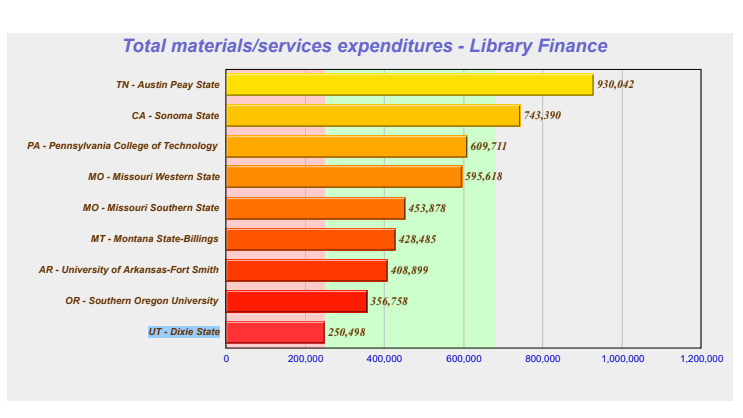
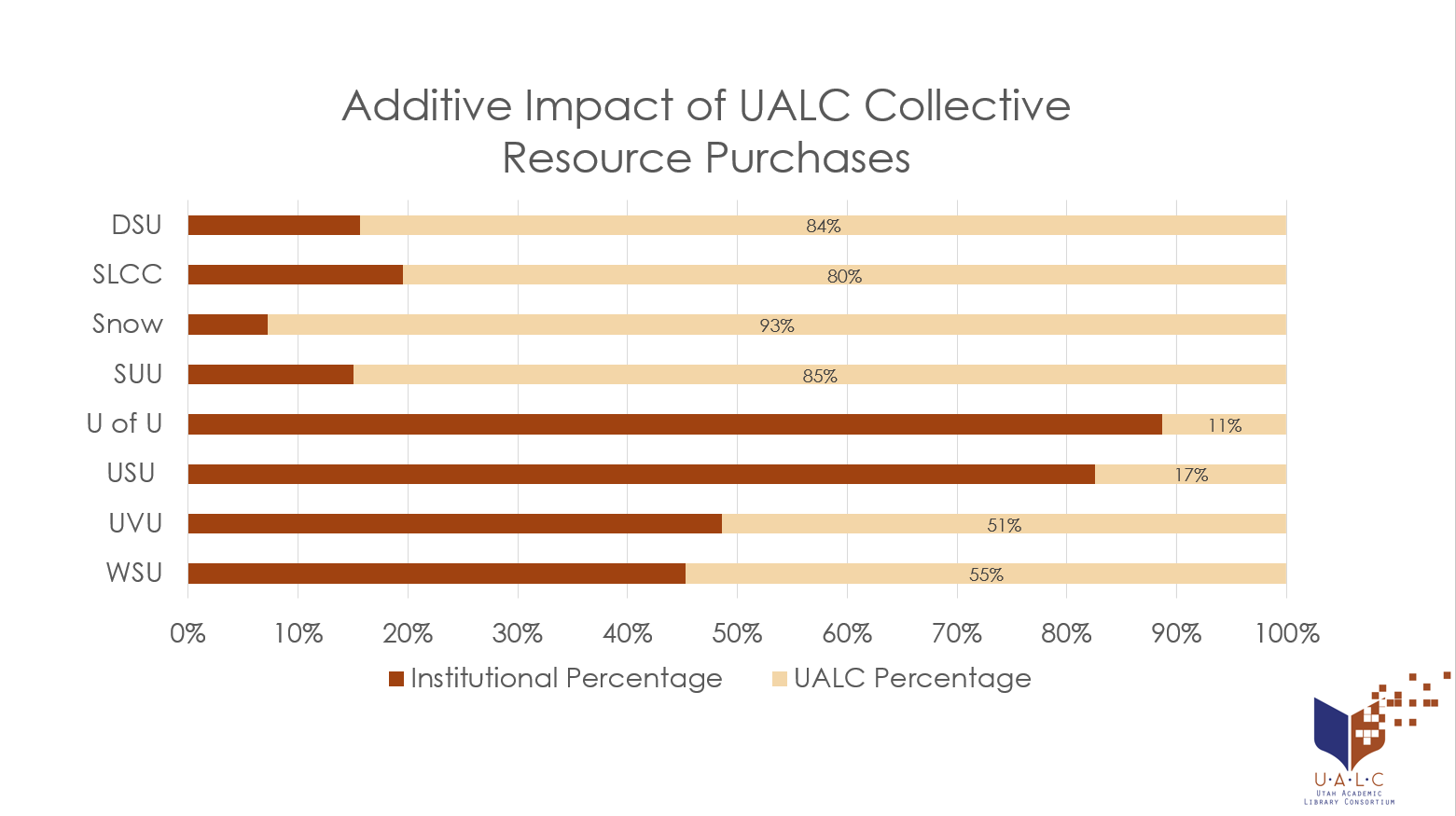
The tutoring centers’ biggest need in the next few years will be additional space. As the programs continues to grow, Learning Services will need additional room.
The library anticipates that we will need additional library faculty as program offerings increase. We particularly feel that having a librarian who specializes in the health sciences would be useful. In addition, the library materials budget will need to be increased at least $20,000 per year to meet the needs of the university.